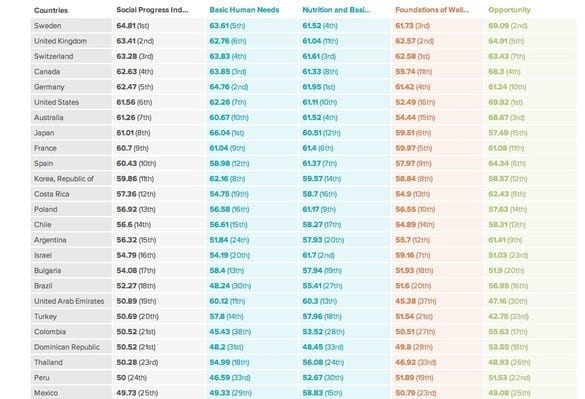
What’s the best way to tell how a country is doing (and serving its citizens)?
It’s not just a measure of economic output, that’s for sure. This new index tracks everything from opportunity to health to sustainability. Guess where the U.S. ranks.
For many years, the powers that be thought that economic indicators were the ultimate measure of a country’s well-being. That’s starting to change. As we have discussedbefore, the general happiness of a country doesn’t always correlate with its wealth. In fact, economic indicators don’t match up with a number of important indicators about well-being.
Hence the Social Progress Index, an initiative from The Social Progress Imperative and Harvard Business School Professor Michael Porter that examines how 50 countries perform on 52 indicators related to basic human needs, the foundations of well-being, and opportunity. The top country: Sweden. The U.S. doesn’t even rank in the top five (it comes it at number six).
The Social Progress Index was hatched at a World Economic Forum working group, where participants decided that they needed common frameworks to measure the problems they were working on. “The big conceptual step was to say that if we’re trying to measure the well-being of a society, the big thing we have to do is actually look at outcomes directly rather than proxy of economic indicators,” explains Michael Green, the executive director of the Social Progress Imperative. “We’re looking at social and environmental outcomes directly, which means that the index isn’t determined by economic factors.”
These social and environmental components include personal safety, ecosystem sustainability, health and wellness, shelter, sanitation, equity and inclusion, and personal freedom and choice. Each component is calculated based on specific outcomes–health and wellness, for example, is determined by life expectancy, obesity, cancer death rate, and other factors.
The 50 countries in the list were chosen because they’re a representative sample of countries around the world. They also encompass 75% of the world’s population. So who made it to the top? Here are the countries with the highest ratings on the SPI (click to zoom). A full list is available on the SPI website.
There are a handful of important trends that we can glean from the index. Almost all of the wealthiest countries do poorly on the ecosystem sustainability component. “The U.S., Canada, and Australia are all struggling with that environmental measure generally,” notes Green. Also, he says, “although economic growth is broadly correlated with social progress, there are departures from that.” One example: Costa Rica (12) performs much better than South Africa (39), even though they have a similar GDP.
While the U.K. and Sweden didn’t perform well on the United Nations Human Development Index, they are at the top of the SPI because they have top marks across the three foundations measured by the index.
The Latest Bing News on:
Social Progress Index
- Social Security fund gains extra year of solvency – benefits will begin to be reduced in 2035on May 9, 2024 at 7:57 am
Social Security benefits are still projected to start running ... and the gap between their goals and progress has never been wider," Aditi Javeri Gokhale, the chief strategy officer, head of ...
- 277,862 Beneficiaries Enroll in Social Health Insurance Scheme in Plateauon May 8, 2024 at 7:37 pm
The Director-General of Plateau State Contributory Healthcare Management Agency (PLASCHEMA), Dr. Agabus Manesseh, has disclosed that significant progress has been made in healthcare accessibility, ...
- Here's How Much 2025's Estimated Social Security COLA Could Add to the Average Checkon May 8, 2024 at 5:31 am
The latest forecast from The Senior Citizens League puts the 2025 Social Security COLA at 2.6%. That's down from the 3.2% we saw this year, and it would be the smallest increase since 2020. The table ...
- Social Security Maps Reveal Areas With Longest Waiting Timeson May 8, 2024 at 5:09 am
New maps produced by the Social Security Administration (SSA) show the areas where disability appeals are taking several hundred days to process. As part of the recently launched SecurityStat program, ...
- Social Security COLA prediction 2025: 3 things to know right nowon May 8, 2024 at 2:01 am
Social Security benefits can go a long way in retirement, and most beneficiaries look forward to getting a raise each year via the cost-of-living adjustment (COLA). Each October, the Social Security ...
- Social Security Administration launches online performance trackeron May 7, 2024 at 7:39 pm
Social Security beneficiaries should receive better support as a result of the SecurityStat online tracking tool that was announced by the SSA today.
- AI Development Holds Key to Economic Growth, Social Progress says Experton May 6, 2024 at 11:28 pm
“In embracing AI, Nigeria stands at the threshold of unprecedented economic opportunities and social development,” Alagbe concludes. However, he emphasizes the urgency of concerted action to propel AI ...
- The Federal Reserve Just Indicated Social Security Could Get a Bigger 2025 Cost-of-Living Adjustment (COLA) Than Expectedon May 6, 2024 at 6:07 am
The Fed is tasked with a dual mandate: to maximize employment while maintaining stable prices. Over the past three years, it's been in a battle with ongoing inflation. Its biggest goal right now is to ...
- Gap Inc. Releases 2023 ESG Report, Sharing Progress on Sustainability and Inclusionon April 30, 2024 at 9:00 am
Gap Inc. (NYSE: GPS) released its 2023 Environmental, Social and Governance (ESG) Report today, marking the company's twentieth year of sustainability reporting and nearly three decades of ...
- Why doing social science research is difficult in India todayon April 29, 2024 at 5:00 pm
With an election under way, the future of Indian science is on the ballot. Encouraging research and critical thinking should be a priority for the new government.
The Latest Google Headlines on:
Social Progress Index
[google_news title=”” keyword=”Social Progress Index” num_posts=”10″ blurb_length=”0″ show_thumb=”left”] [/vc_column_text]The Latest Bing News on:
National Well-Being
- A check-up on the nursing profession in CT during National Nurses Weekon May 9, 2024 at 7:25 am
Connecticut has roughly 90,000 registered nurses, but only a little over 50% are actually working in the nursing profession.
- Book your stay at one of South African National Parks world-renowned natural getawayson May 9, 2024 at 7:18 am
South African National Parks boast of having world-renowned natural getaways that not only make them easily accessible holiday destinations but also serve the purpose of participating in holistic ...
- Pelvic Rehabilitation Medicine Founders Honored for Revolutionizing Pelvic Pain Treatment and Creating National Impacton May 9, 2024 at 2:54 am
May 9, 2024 /PRNewswire/ -- Pelvic Rehabilitation Medicine (PRM), the premier, multi-disciplinary national leader in pelvic pain and ... that are dedicated to progress and enhancing patients' ...
- Longtime nurse at Boys Town in Omaha honored during ‘National Nurses Week’on May 8, 2024 at 8:12 pm
This week, all over the U.S., nurses are being recognized for the invaluable contributions they make for those who need care. It’s National Nurse’s Week.
- Governor Youngkin and First Lady recognize National Fentanyl Awareness Dayon May 8, 2024 at 3:30 pm
These events are part of the It Only Takes One campaign against fentanyl led by the First Lady and Attorney General Jason Miyares.
- Saint Joseph London Earns National Recognition With An 'A' Hospital Safety Grade From The Leapfrog Group for the Second Consecutive Grading Periodon May 8, 2024 at 3:19 pm
Saint Joseph London has earned an "A" Hospital Safety Grade from The Leapfrog Group, a national nonprofit watchdog that sets standards for excellence in patient care. Leapfrog assigns an "A," "B," "C, ...
- National Politicson May 8, 2024 at 9:51 am
Israel has ordered the evacuation of 100,000 Palestinians from the city. Israeli forces have also carried out what it describes as “targeted strikes” on the eastern part of Rafah and ...
- Washoe County School district celebrates National School Nurse Dayon May 8, 2024 at 9:20 am
The Washoe County School District (WCSD) is celebrating the work of school nurses on National School Nurse Day on May 8. School nurses protect the health and welfare of students ...
- Growth and economic well-being: Fourth quarter 2023, OECDon May 7, 2024 at 2:58 am
Real household income per capita in the OECD rose by 0.5% in the fourth quarter of 2023, following a 0.2% fall in the third quarter. Growth in real income per capita exceeded growth in real GDP per ...
- Miss USA steps down: ‘Never compromise your physical and mental well-being’on May 6, 2024 at 2:44 pm
The woman who holds the title of Miss USA says she’s giving up her crown, citing her “physical and mental well-being” in an announcement about her resignation.
The Latest Google Headlines on:
National Well-Being
[google_news title=”” keyword=”National Well-Being” num_posts=”10″ blurb_length=”0″ show_thumb=”left”]









